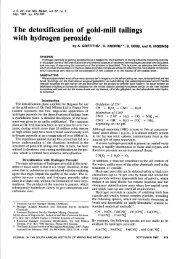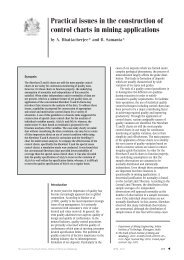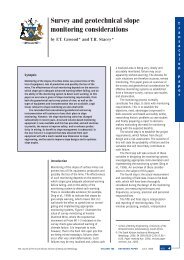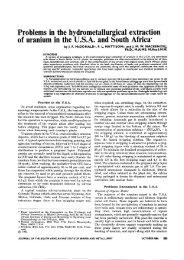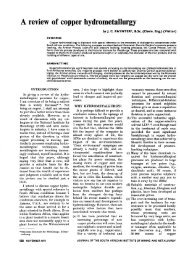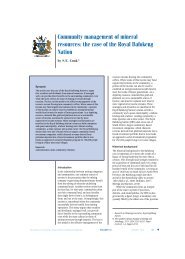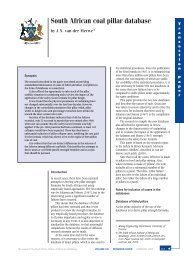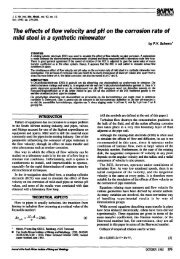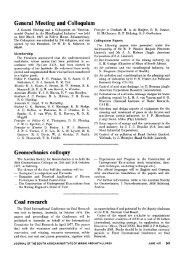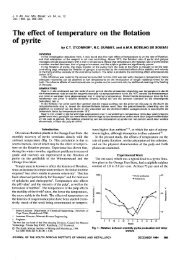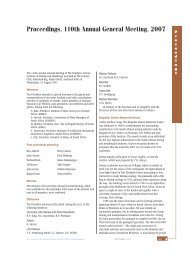Fundamental Studies of the Flotation Process: - saimm
Fundamental Studies of the Flotation Process: - saimm
Fundamental Studies of the Flotation Process: - saimm
You also want an ePaper? Increase the reach of your titles
YUMPU automatically turns print PDFs into web optimized ePapers that Google loves.
The finding that <strong>the</strong> abstraction <strong>of</strong> xanthate by galena<br />
is a continuing process that does not reach completion or<br />
equilibrium is <strong>of</strong> <strong>the</strong> greatest importance and has<br />
necessarily influenced <strong>the</strong> course <strong>of</strong> subsequent work. It<br />
implies that <strong>the</strong> reaction is not reversible and that <strong>the</strong><br />
extent <strong>of</strong> reaction is no longer a primary parameter that<br />
can be related simply to such variables as <strong>the</strong> concentrations<br />
<strong>of</strong> xanthate and <strong>of</strong> oxygen, pH, and temperature.<br />
The system can effectively be studied only with<br />
reference to <strong>the</strong> kinetics <strong>of</strong> reaction. Therefore, <strong>the</strong> next<br />
stage <strong>of</strong> <strong>the</strong> work emphasized <strong>the</strong> determination <strong>of</strong><br />
rates <strong>of</strong> reaction.<br />
The second stage <strong>of</strong> development was carried out with<br />
an apparatus17 shown in Fig. 3 that was similar to that<br />
used previously, in that solutions having passed through<br />
a fluid bed <strong>of</strong> mineral were analysed for <strong>the</strong>ir xanthate<br />
content and <strong>the</strong>n discarded. However, provision was<br />
made for <strong>the</strong> concentration <strong>of</strong> oxygen in <strong>the</strong> entering<br />
solution to be precisely controlled. It was found17 that<br />
two distinct reactions between xanthate, oxygen, and<br />
galena could be distinguished. The first <strong>of</strong> <strong>the</strong>se results<br />
in <strong>the</strong> adsorption <strong>of</strong> xanthate, and <strong>the</strong> second gives rise<br />
to soluble products. The adsorption reaction predominates<br />
in <strong>the</strong> early stages <strong>of</strong> contact between oxygencontaining<br />
xanthate solutions and 'clean' galena, and<br />
follows an exponential rate equation:<br />
dqfdt=f3 expo (-aq),<br />
where q is <strong>the</strong> quantity <strong>of</strong> xanthate adsorbed and a and<br />
f3 are constants. At any time, both <strong>the</strong> rate and <strong>the</strong> extent<br />
<strong>of</strong> adsorption vary directly with <strong>the</strong> square root <strong>of</strong><br />
<strong>the</strong> partial pressure <strong>of</strong> oxygen in solution. The second<br />
type <strong>of</strong> reaction becomes predominant once <strong>the</strong> rate <strong>of</strong><br />
adsorption has been sufficiently reduced by <strong>the</strong> accumulation<br />
<strong>of</strong> adsorption products. This reaction is responsible<br />
for <strong>the</strong> continuing abstraction <strong>of</strong> xanthate from solution,<br />
which had been noted in <strong>the</strong> first stages <strong>of</strong> experimentation.<br />
After several hours <strong>of</strong> contact between <strong>the</strong> surface<br />
and <strong>the</strong> reagent, this reaction proceeds at a constant<br />
rate, which also varies with <strong>the</strong> square root <strong>of</strong> <strong>the</strong> partial<br />
pressure <strong>of</strong> oxygen in solution. Although it was not found<br />
possible to identify <strong>the</strong> chemical changes taking place, it<br />
was noted that <strong>the</strong> reaction was associated with <strong>the</strong><br />
appearance <strong>of</strong> a water-soluble product that was tentatively<br />
identified as <strong>the</strong> monothiocarbonate ROCOS-.<br />
It can be seen that this substance can be obtained from<br />
<strong>the</strong> equivalent xanthate, ROCS;, by replacement <strong>of</strong><br />
one <strong>of</strong> <strong>the</strong> sulphur atoms with oxygen.<br />
The design <strong>of</strong> <strong>the</strong> second apparatus did not allow<br />
meaningful observations to be made within <strong>the</strong> first<br />
20 minutes <strong>of</strong> contact between <strong>the</strong> solutions and <strong>the</strong><br />
mineral. This meant that <strong>the</strong> results do not apply to <strong>the</strong><br />
reactions that are <strong>of</strong> primary importance in flotation.<br />
Accordingly, attention was focused on <strong>the</strong> development<br />
<strong>of</strong> an apparatus that would allow this early period to be<br />
studied, and would also allow <strong>the</strong> consumption <strong>of</strong><br />
oxygen during reaction to be monitored. After a prolonged<br />
period <strong>of</strong> unsuccessful innovation, <strong>the</strong> apparatus<br />
shown in Fig. 4 was developed31. In use, suitably pretreated<br />
galena is dropped into <strong>the</strong> upward-flow column,<br />
which contains a solution <strong>of</strong> <strong>the</strong> reagents that are required<br />
for <strong>the</strong> particular experiment. The column is <strong>the</strong>n<br />
sealed in closed circuit with a spectrophotometer cell for<br />
determining <strong>the</strong> concentration <strong>of</strong> xanthate, a Clark<br />
electrode for monitoring <strong>the</strong> concentration <strong>of</strong> dissolved<br />
oxygen, and a completely sealed glass centrifugal pump.<br />
This system is capable <strong>of</strong> yielding meaningful results<br />
within 2 minutes <strong>of</strong> <strong>the</strong> commencement <strong>of</strong> reaction and<br />
has proved itself to be extremely productive. The<br />
results are very much more reproducible than those<br />
obtained by <strong>the</strong> previous techniques.<br />
Whereas numbers <strong>of</strong> reliable observations have been<br />
made by this technique, <strong>the</strong> work <strong>of</strong> interpretation is<br />
still in progress. At this time, however, a number <strong>of</strong><br />
interesting findings can be mentioned.<br />
1. The two stages <strong>of</strong> reaction, which are again<br />
clearly revealed, are characterized by different<br />
values <strong>of</strong> <strong>the</strong> stoichiometric ratio - number <strong>of</strong><br />
molecules <strong>of</strong> xanthate reacted to number <strong>of</strong><br />
molecules <strong>of</strong> oxygen reacted. The ratio has a value<br />
<strong>of</strong> two in <strong>the</strong> first stage <strong>of</strong> reaction and, depending<br />
on <strong>the</strong> conditions, varying values <strong>of</strong> less than one<br />
in <strong>the</strong> second stage.<br />
2. Clear confirmation was obtained that <strong>the</strong> final,<br />
continuing stage <strong>of</strong> <strong>the</strong> abstraction <strong>of</strong> xanthate is<br />
due to <strong>the</strong> formation <strong>of</strong> monothiocarbonate.<br />
3. Under certain conditions <strong>of</strong> pH and xanthate<br />
concentration, adsorbed xanthate is converted to<br />
monothiocarbonate (MTC-) at <strong>the</strong> surface, which<br />
<strong>the</strong>n desorbs. It is thought that this effect might<br />
take place by reaction between adsorbed lead<br />
xanthate and lead hydroxide:<br />
Pb(OHh+PbX2+20H + 2MTC- +2PbS+~O.<br />
4. The new experimental technique allows <strong>the</strong><br />
quantity <strong>of</strong> monothiocarbonate formed at any<br />
time to be accurately determined and, <strong>the</strong>refore,<br />
<strong>the</strong> amount <strong>of</strong> xanthate adsorbed at <strong>the</strong> surface to<br />
be estimated. Thus it has been shown that <strong>the</strong><br />
adsorption <strong>of</strong> xanthate can be reversed if suitable<br />
adjustments are made to <strong>the</strong> concentration or pH<br />
<strong>of</strong> <strong>the</strong> solution with which it is in contact. Whereas<br />
it is not yet certain how quantitative and complete<br />
this reversibility is, it seems highly probable<br />
that former indications <strong>of</strong> <strong>the</strong> adsorption <strong>of</strong><br />
xanthate as irreversible derived from confusion<br />
between adsorption and <strong>the</strong> side reaction by which<br />
xanthate is converted to monothiocarbonateand<br />
<strong>the</strong> latter certainly could not be reversed<br />
under <strong>the</strong> conditions obtaining in flotation.<br />
5. The total rate <strong>of</strong> consumption <strong>of</strong> oxygen by<br />
galena is decreased by <strong>the</strong> presence <strong>of</strong> xanthate.<br />
PRODUCTS OF REACTION BETWEEN THIOLS<br />
AND METAL SULPHIDES19, 20<br />
The investigation <strong>of</strong> <strong>the</strong> nature <strong>of</strong> <strong>the</strong> products <strong>of</strong><br />
reaction was prompted by <strong>the</strong> controversy that has<br />
grown up in <strong>the</strong> literature between those authors who<br />
believe <strong>the</strong> product <strong>of</strong> reaction between xanthates and<br />
sulphide minerals to be <strong>the</strong> metal xanthate, those who<br />
believe it to be dixanthogen, and those who believe it<br />
to be a mixture <strong>of</strong> <strong>the</strong> two. In <strong>the</strong> case <strong>of</strong> galena, <strong>the</strong><br />
most convincing piece <strong>of</strong> evidence in favour <strong>of</strong> dixanthogen<br />
was provided by <strong>the</strong> work <strong>of</strong> Abramov32, who<br />
used infrared spectroscopy to identify <strong>the</strong> products extracted<br />
from <strong>the</strong> surface <strong>of</strong> xanthated galena. When<br />
JOURNAL OF THE SOUTH AFRICAN INSTITUTE OF MINING AND METALLURGY FEBRUARY 1972 201




